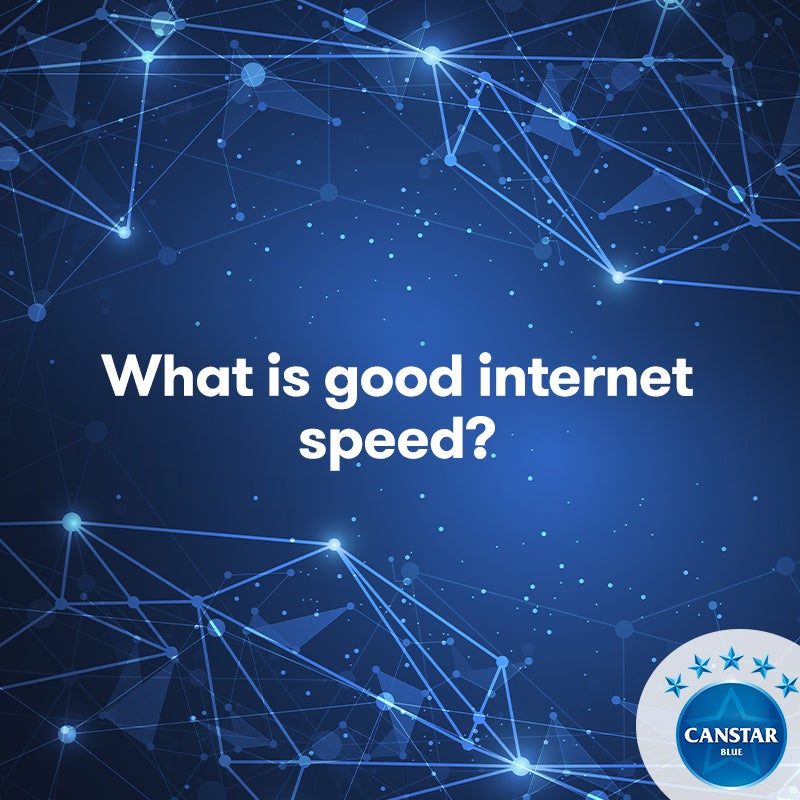Choosing an internet plan for your home can be a difficult decision. But thanks to the introduction of the NBN, customers have more choice, and the ability to select a speed that better reflects their needs. This is good news for consumers, especially if you want a faster internet plan. However, this can be a confusing experience: how do you decide what speed you actually need at home? What actually is a good internet speed?
Let’s take a look at the NBN speeds on offer, and how you can select an NBN plan with an internet speed that best suits your needs.
On this page:
NBN offers you might like
The following table shows a selection of sponsored unlimited data Standard Plus Evening Speed (NBN 50), and Premium Evening Speed (NBN 100) plans on Canstar Blue’s database with links to referral partners.
 |
1 Month Contract (1 month min. cost $105) Typical evening speed of 97Mbps
|
Unlimited Data/month |
$105 Cost/month |
Go to Site |
 |
1 Month Contract (1 month min. cost $79.99) Typical evening speed of 96Mbps
|
Unlimited Data/month |
$79.99 Cost/month |
Go to Site |
 |
1 Month Contract (1 month min. cost $75) Typical evening speed of 50Mbps
|
Unlimited Data/month |
$75.00 Cost/month |
Go to Site |
Unlimited Home Standard (NBN 50) Plans
The following table shows a selection of published unlimited NBN 50 plans on Canstar Blue’s database, listed in order of standard monthly cost (excluding discounts), from the lowest to highest, and then by alphabetical order of provider. Use our comparison tool above to see plans from a range of other providers. This is a selection of products with links to referral partners.
Unlimited Home Fast (NBN 100) Plans
The table below shows a selection of published unlimited NBN 100 plans on Canstar Blue’s database, listed in order of monthly cost, from the lowest to highest, and then by alphabetical order of provider. Use our comparison tool to see plans from a range of other providers. This is a selection of products with links to referral partners.
What is a good internet speed in Australia?

Firstly, when talking about internet speeds, we’re typically talking about what is a good download speed, as most online activity uses downloads. You can safely say you’re getting a good internet speed if you’re recording download speeds of around 25Mbps. While home internet speeds can get a lot faster, 25Mbps will support most online activity such as HD streaming, online gaming, web browsing and general downloading.
However, for an improved experience, it’s worth considering whether more expensive internet plans with download speeds of 50Mbps or more are worth paying extra for, especially if you’re expecting your home internet to support multiple devices and users at the same time.
Test your internet speed with our free tool
How fast are NBN speeds?
Speeds for uploading and downloading content are measured in Megabits per second (Mbps). Each speed tier is measured in Mbps, which determines the number of megabits your internet can download and upload in a second. Currently, NBN offers six different speed tiers. The Mbps listed for each of these speeds is reference to the maximum download and upload speeds that may be experienced on these speed tiers.
- Home Basic I or NBN 12 (previously Basic NBN speed): 12Mbps download, 1Mbps upload
- Home Basic II or NBN 25 (previously Standard NBN speed): 25Mbps download, 5Mbps upload
- Home Standard or NBN 50 (previously Standard Plus NBN speed): 50Mbps download, 20Mbps upload
- Home Fast or NBN 100 (previously Premium NBN speed): 100Mbps download, 20Mbps or 40Mbps upload
- Home Superfast or NBN 250: 250Mbps download, 25Mbps upload
- Home Ultrafast or NBN 1000: 1000Mbps download, 50Mbps upload
When you’re comparing NBN plans, you may notice reference to evening speeds — this might be in the name of the plan itself, or in the provider’s NBN speed guide. The use of evening speeds was introduced by the ACCC to ensure that internet service providers (ISPs) are much more transparent about NBN speeds and to make it easier for consumers to compare and select the right speed tier for their needs. This term refers to speeds during evening peak times (between the hours of 7pm-11pm), which is when there is typically more congestion on the network.
You might find that when you’re looking at a specific plan from a telco, the ‘typical evening speed’ listed, could be less than the maximum download speed available on that speed tier. The ACCC offers a guide for the evening speeds that you can usually expect on the different speed tiers to help you identify if your NBN plan is perhaps not performing as it should be. When choosing a new NBN plan, look for providers that list this ‘typical evening speed’, as this can help you with your NBN plan comparisons.
NBN speeds compared
Once you’ve established what your household internet needs are, it’s time to look at which speed tier will best suit you and your family. The following table includes the four most commonly available NBN speed tiers, and recommendations as to what activities are suitable on these speeds. Keep in mind that these are only a guide — NBN service can differ between providers and due to a range of factors, just as each household’s requirements are different.
| Speeds | Typical evening speeds | Recommended household size | Recommended use | |
|---|---|---|---|---|
| Home Basic I | 12/1Mbps: 12Mbps download, 1Mbps upload | 7Mbps-12Mbps | 1-2 people, light users | Light web browsing, emails and home phone |
| Home Basic II | 25/5Mbps: 25Mbps download, 5Mbps upload | 15Mbps-25Mbps | 2-3 people light to moderate users | Moderate web browsing, social media browsing, sending emails, SD video streaming, music streaming |
| Home Standard | 50/20Mbps: 50Mbps download, 20Mbps upload | 30Mbps-50Mbps | 3-4 people, moderate to heavy users | HD video streaming, music streaming, online gaming, sharing/uploading photos, video calling |
| Home Fast | 100/40Mbps or 100/20: 100Mbps download, 40Mbps upload or 20Mbps upload | 60Mbps-100Mbps | 5+ people, heavy users | 4K video streaming, downloading large files (faster uploading with 100/40 speeds), online gaming, heavy internet use over multiple devices simultaneously |
| Home Superfast | 250/25Mbps: 250Mbps download, 25Mbps upload | 200Mbps-250Mbps | 6+ people, heavy users | Concurrent 4K video streaming, downloading large files, online gaming, heavy internet use over multiple devices simultaneously, uninterrupted video calls |
| Home Ultrafast | 1000/50Mbps: 1000Mbps download, 50Mbps upload | 200Mbps-700Mbps | 6+ people, heavy users | Concurrent 4K video streaming, uploading/downloading large files, online gaming, heavy internet use over multiple devices simultaneously, seamless high-quality video calls |
Which NBN speed tiers deliver the best internet speeds?
The NBN 50 speed tier is the most popular speed in Australia, so download speeds of around 50Mbps can generally be considered ‘good’. This should be more than enough for a decent amount of evening web browsing, social media and video streaming at a high standard, and it is also the fastest speed available to most NBN connection types. The NBN 12 and NBN 25 speed tiers should be equally capable of meeting your more basic internet needs, but in an effort to strike the best balance between speed performance and price, NBN 50 can reasonably be considered the way to go.
Choosing the best NBN plan for you
Now that you’ve got an idea as to which speed tier will most likely suit your household, you’ll need to compare NBN plans from a range of providers to help you choose the best NBN plan to suit your needs. There is a lot of competition on the market when it comes to NBN providers in Australia. However, not all providers offer plans on all six of the speed tiers, which could help make your NBN plan comparisons a little easier.
To help you choose a NBN plan, we’ll take a look at several options across the four most widely available speed tiers to give you an idea of plans and prices available.
Unlimited NBN 100 Plans
The following table shows a selection of published unlimited NBN 100 plans on Canstar Blue’s database, listed in order of standard monthly cost, from the lowest to highest, and then by alphabetical order of provider. Use our comparison tool above to see plans from a range of other providers. This is a selection of products with links to referral partners.
Unlimited NBN 50 Plans
The following table shows a selection of published unlimited NBN 50 plans on Canstar Blue’s database, listed in order of standard monthly cost, from lowest to highest, and then by alphabetical order of provider. Use our comparison tool above to see plans from a range of other providers. This is a selection of products with links to referral partners.
Unlimited NBN 25 Plans
The following table shows a selection of published unlimited NBN 25 plans on Canstar Blue’s database, listed in order of standard monthly cost, from the lowest to highest, and then by alphabetical order of provider. Use our comparison tool above to see plans from a range of other providers. This is a selection of products with links to referral partners.
Unlimited NBN 12 Plans
The following table shows a selection of published unlimited NBN 12 plans on Canstar Blue’s database, listed in order of standard monthly cost, from the lowest to highest, and then by alphabetical order of provider. Use our comparison tool above to see plans from a range of other providers. This is a selection of products with links to referral partners.
The following tables show a selection of unlimited Home Superfast (NBN 250) plans on Canstar Blue’s database listed in order of standard monthly cost, from lowest to highest. Use our comparison tool to see plans from a range of other providers. This is a selection of products with links to a referral partner.
The following tables show a selection of unlimited Home Ultrafast (NBN 1000) plans on Canstar Blue’s database listed in order of standard monthly cost, from lowest to highest. Use our comparison tool to see plans from a range of other providers. This is a selection of products with links to a referral partner.
How fast is home wireless broadband and mobile broadband?
NBN isn’t the only type of internet service out there. While NBN includes fibre, fixed wireless and satellite services, many providers also offer home wireless broadband and mobile broadband services.
Both home wireless and mobile broadband offer internet connections via a mobile network — the same as the internet connection you get from your phone plan. The big difference between the two internet types is that home wireless broadband (sometimes called 4G or 5G home internet) is designed as an internet service for the home, where multiple devices can connect to the WiFi, and plans often include unlimited data.
Mobile broadband is a portable form of internet. It can come in the form of a data-only SIM card that you insert into your tablet or other device (like a modem or dongle) or as a plan bundled with a portable modem or dongle. These plans will often have smaller data inclusions and are aimed for use in a tablet or for use while travelling or on the go.
Both home wireless and mobile broadband are available as 4G-only plans or 5G plans (where available). Whether you choose 4G or 5G will determine what internet speeds you’ll get on your plan. 5G offers much faster speeds than 4G, however some providers may also cap your internet speeds.
4G home internet plans are typically capped around 20Mbps, while 5G plans might have speeds capped at 50Mbps and around 100Mbps, with the slower plan usually at a cheaper cost. Some plans, especially 5G home internet, might not have speed caps at all and might reach speeds around 300-500Mbps. Mobile broadband plans may also have similar speed caps in place to home wireless plans.
How do I know which internet speed I need?
When you’re choosing an NBN speed tier and plan, you’ll need to assess your household situation to determine which speed will be the best NBN speed for your household. It’s also a similar decision when you’re looking at home wirless plans and whether you need 4G or 5G home internet.
There are a number of factors that could determine which speed will best suit your needs. As a guide, consider the following:
- How many people are in the house, and will they be using the internet simultaneously?
- How many devices require connection to a WiFi network and will they all be used at the same time? (Smart TVs, gaming consoles, mobiles, tablets, computers, smart home assistants, security systems, etc)
- What do you use the internet for? (General web browsing, sending emails, streaming video and music, online gaming, video calls, uploading and downloading large files, etc.)
While some activities, such as general web browsing and social media, may only require around 1-2Mbps, load times might be slow. If you’re streaming video, your required internet speed will depend on the quality of the video that you’re streaming. A standard-definition video stream requires around 3Mbps; however 1.5Mbps is considered adequate for streaming on your smartphone, as telcos often use this data speed for the ‘unlimited data’ mobile plans or data-free streaming options.
If you want to stream videos in high definition or 4K, you’ll need much faster speeds, particularly if you’re streaming on your TV. Around 5Mbps is enough for high-definition streaming, while 4K streaming requires much more — 25Mbps. If multiple people will be streaming video at the same time, especially in HD, you’re probably going to need a higher speed tier plan.
For example, if two people were watching Netflix simultaneously in high definition (on separate devices) during the peak evening time, that’s around 10Mbps in total being used at the same time. Most of the NBN 12 plans on the market offer a typical evening speed of around 11Mbps (or even lower), leaving not much bandwidth for anything else. Even the NBN 25 plans are generally better suited to standard-definition video streaming, with a minimum typical evening speed of 15Mbps.

What can I really expect from my internet speed?
There are many factors that come into play with your NBN connection. The speed tiers are really a guide as to the maximum speed available on that plan: however, the actual speeds you experience could be different. The same can be said for home wireless and mobile broadband.
Your internet speed can be affected by a range of factors, including the hardware you’re using to connect to the internet, your NBN connection type (how your home is connected to the NBN network), your distance from the server you’re trying to connect to and of course, network congestion and mobile network coverage (in the case of home wireless and mobile broadband).
That evening peak time can have a big impact on the internet speeds you experience, which is why the ACCC introduced evening speed recommendations. The ACCC also releases a quarterly speed report which can give you an indication as to how some of the bigger NBN providers stack up when it comes to speed. If you’re looking into plans from any of the providers that are compared by the ACCC, you might find this guide to be a useful indicator as to the peak evening speeds you might experience.
Of course, it’s difficult to determine the actual speeds you’ll receive on your internet plan. When you are signing up to an internet plan, if that provider does not include an indication of speeds you can expect during the evening peak, it’s recommended that you ask for that information. If you feel the speeds you’re experiencing do not match up to what your plan has indicated, you should get in touch with your internet provider.
When it comes to finding the best internet plan, the choice is ultimately yours. To help you find the right plan and speed tier to suit your needs, it’s worth doing a comparison of plans and providers to see what options are out there. Be realistic with what your internet needs are: if you’re not sure about which speed will suit your household, it might be worth finding a month-to-month no lock-in contract plan, so you can switch to a different speed tier if you feel your current plan isn’t the right option for your household.




Share this article